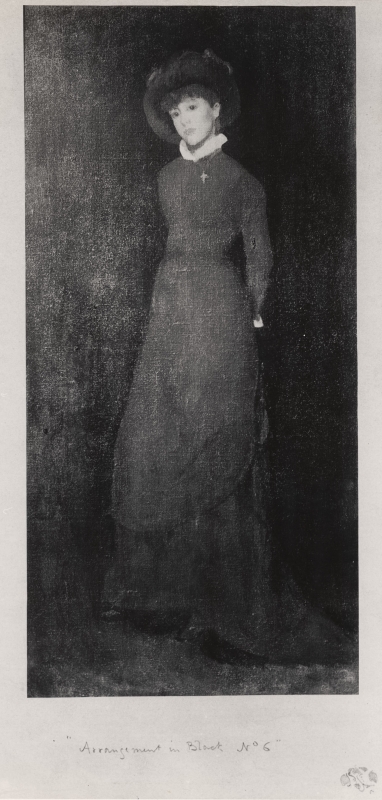Provenance
Unknown.
Exhibitions
- 1882: VI Summer Exhibition, Grosvenor Gallery, London, 1882 (cat. no. 127) as 'Harmony in Black and Red'.
In the spring of 1882 Whistler wrote to Théodore Duret (1838-1927) about an exhibition in Paris, rue de Sèze, presumably at the Galerie Georges Petit,
'I see that there is to be an Exhibition in the Rue du Seze with Alfred Stevens and de Nitis at the head - Do you not think that I might send as representing America? I should very much like to let them have the other picture that you were so well pleased with / I mean the one of Madame in black - with the black hat and red feather - In a certain way you know as execution we were both of opinion that it was a progress and I think the one would appeal to the artists and explain or help the other - Will you ask about all this and let me know?' 1
The 'other' was Arrangement in Black: Lady Meux [YMSM 228]; in calling Harmony in Black and Red [YMSM 236], 'Arrangement in Black No. 6', Whistler was confirming its relationship with that portrait. Whistler had hoped they might be seen together in Paris, but this does not seem to have happened. J. E. Blanche mentions seeing a portrait of Maud Franklin exhibited in Paris in 1883, but may have confused it with Arrangement in Brown and Black: Portrait of Miss Rosa Corder [YMSM 203], which was at the Petit exhibition in that year.
Meanwhile, the painting received a poor reception from art critics. The Era on 5 May enquired if Whistler painted 'with a sponge and a scrubbing brush'. Punch, on 27 May 1882, caricatured it unflatteringly as 'The Ghost in the Haunted Coalhole'. 2 Knowledge was particularly nasty in its comments, describing the portrait as:
'We are shown a sooty-faced, ill-shaped creature (do look at that left arm!), on a dirty-black background, with smears of vermillion on necklace, lips, and hat, and we are told it is – not a Horror in Soot and Ochre, as out eyes tell us – but (forsooth) a harmony in Black and Red!' 3

R. Hallward after Whistler 'Harmony in Black and Red', woodcut, Illustrated London News, 22 July 1882
A not very good wood engraving in the Illustrated London News, 22 July 1882, calls it 'The Blue Girl', confusing it with Scherzo in Blue: The Blue Girl [YMSM 226] in the same exhibition. Whistler wrote complaining of this 'new libel' to Edmund Hodgson Yates (1831-1894) of The World:
'Have you seen the woodcuts in the Illustrated London News of last week? -
I discover to my chagrin that a small monstrosity by way of new libel on my painting in the Grosvenor has found a place in that largely circulated journal -
… doubtless the Art Director of your Contemporary can at least read, and would scarcely have offered, as the "Blue Girl," what in the Catalogue is entitled "Arrangement in Black & Red" -
... here we have the blind led by the Color blind ... Useless perhaps in these days of aesthetic artisans and cultivated woodcutters to complain of the ugly work - for probably the original itself does not convey an impression of beauty to the culture crowded craftsman employed in translating us - Still I submit that - however faintly - there is yet suggested a less brutal [awkwardness] of young lady ... a less stolid capacity for murder than is to be propagated to the four quarters of the globe as the truth respecting Mr. Whistler's picture.' 4
Notes:
1: [March/April 1882], GUW #09639.
2: Punch, 27 May 1882, caricature repr. p. 240.
3: Anon., 'The Grosvenor Gallery', Knowledge: An Illustrated Magazine of Science …', no. 32, 9 June 1882, pp. 17-18. See also Getscher 1986 [more] , p. 191, J. 101.
4: [24/28 July 1882], GUW #07109. The letter was not published.
Last updated: 10th November 2020 by Margaret





